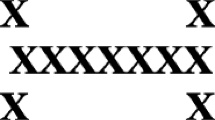Summary
Spectral sensitivity functions of a passeriform bird, the Red-billed Leiothrix Leiothrix lutea (Timalidae) were determined in a behavioural test under different background illuminations.
-
1.
With photopic illumination the spectral sensitivity of Leiothrix lutea covered the measured range from 320 nm to 680 nm. Four peaks of spectral sensitivity were found: a UV (370 nm), a blue (460 nm), a green (530 nm) and a red (620 nm) sensitivity peak. The spectral sensitivity was highest in the UV and decreased (over the blue and the green peak) towards the red sensitivity peak. The 4 peaks of spectral sensitivity point to 4 underlying cone mechanisms under photopic illumination and thus to a probably tetrachromatic colour vision of Leiothrix lutea.
-
2.
With mesopic illumination the bird's spectral sensitivity covered the measured range from 320 nm to 680 nm. Neural interactions between cone and rod sensitivities are likely to determine this function. The increased overall sensitivity and a dominant sensitivity peak at 500 nm point to a typical rhodopsin as the likely rod photopigment.
-
3.
Different aspects of the biological significance of the high UV sensitivity are discussed.
Similar content being viewed by others
References
Able KP (1989) Skylight polarization patterns and the orientation of migratory birds. J Exp Biol 141:241–256
Bowmaker JK (1980) Birds see ultraviolet light. Nature 284:306
Bowmaker JK, Kunz YW (1987) Ultraviolet receptors, tetrachromatic colour vision and retinal mosaics in the brown trout (Salmo trutta): age-dependent changes. Vision Res 27:2101–2108
Bowmaker JK, Martin GR (1985) Visual pigments and oil droplets in the penguin, Spheniscus humboldti. J Comp Physiol A 156:71–77
Bridges CDB (1967) Spectroscopic properties of porphyropsin. Vision Res 7:349–369
Burkhardt D (1982) Birds, berries and the UV. Naturwissenschaften 69:153–157
Burkhardt D (1989) A bird's eye view of feathers. J Comp Physiol A 164:787–796
Burkhardt D, Maier E (1989) The spectral sensitivity of a passerine bird is highest in the UV. Naturwissenschaften 76:82–83
Chen DM, Goldsmith TH (1986) Four spectral classes of cone in the retinas of birds. J Comp Physiol A 159:473–479
Chen DM, Collins JS, Goldsmith TH (1984) The ultraviolet receptor of bird retinas. Science 225:337–340
Eisner T, Silberglied RE, Aneshansley D, Carrel JE, Howland HC (1969) Ultraviolet video-viewing: the television camera as an insect eye. Science 166:1172–1174
Goldsmith TH (1980) Hummingbirds see near ultraviolet light. Science 207:786–788
Goldsmith TH (1990) Optimization, constraint, and history in the evolution of eyes. Q Rev Biol 65:281–322
Goldsmith TH, Collins JS, Licht S (1984) The cone oil droplets of avian retinas. Vision Res 24:1661–1671
Govardovskij VI, Zueva LV (1977) Visual pigments of chicken and pigeon. Vision Res 17:537–543
Hawryshyn CW, McFarland WN (1987) Cone photoreceptor mechanism and the detection of polarized light in fish. J Comp Physiol A 160:459–465
Helbig AJ (1990) Depolarization of natural skylight disrupts orientation of an avian nocturnal migrant. Experientia 46:755–757
Heiversen O von (1972) Zur spektralen Unterschiedsempfindlichkeit der Honigbiene. J Comp Physiol 80:439–472
Huth HH, Burkhardt D (1972) Der spektrale Sehbereich eines Violettohr-Kolibris. Naturwissenschaften 59:650
Jane SD, Bowmaker JK (1988) Tetrachromatic colour vision in the duck (Anas platyrhynchos L): microspectrophotometry of visual pigments and oil droplets. J Comp Physiol A 162:225–235
Kirschfeld K (1982) Carotenoid pigments: their possible role in protecting against photooxidation in eyes and photoreceptor cells. Proc R Soc Lond B 216:71–85
Kreithen ML, Eisner T (1978) Ultraviolet light detection by the homing pigeon. Nature 272:347–348
Le Grand Y (1972) Spectral luminosity. In: Jameson D, Hurvich LM (eds) Visual psychophysics (Handbook of sensory physiology, VII/4). Springer, Berlin Heidelberg New York, pp 413–433
Lutz FE (1933) “Invisible” colors of flowers and butterflies. Natural History XXXIII: 565–576
Maier EJ (1990) Verhaltensphysiologische Untersuchungen zum Farbensehen des Sonnenvogels (Leiothrix lutea, Timalidae, Passeriformes): Spektrale Empfindlichkeit und selektive chromatische Adaptation unter Berücksichtigung des UV-Bereiches. Doctoral thesis, Univ Regensburg
Neumeyer Ch (1988) Das Farbensehen des Goldfisches. Georg Thieme, Stuttgart New York
Neumeyer Ch, Wietsma JJ, Spekreijse H (1991) Seperate processing of “color” and “brightness” in goldfish. Vision Res 31:537–549
Parrish J, Smith R, Benjamin R, Ptacek J (1981) Near ultraviolet light reception in mallards and passeriformes. Trans Kans Acad Sci 84:147
Reed JR (1987) Scotopic and photopic spectral sensitivities of boobies. Ethology 76:33–55
Remy M, Emmerton J (1989) Behavioral spectral sensitivities of different retinal areas in pigeons. Behav Neurosci 103:170–177
Ripps A, Weale RA (1976) In: Davson H (ed) The eye, vol 2A, Visual function in man. Academic Press, New York London San Francisco, pp
Rossel S (1987) Das Polarisationssehen der Bienen. Naturwissenschaften 74:53–62
Schwind R (1985) Sehen unter und über Wasser. Sehen von Wasser: Das Sehsystem eines Wasserinsektes. Naturwissenschaften 72:343–352
Silberglied RE (1979) Communication in the ultraviolet. Annu Rev Ecol Syst 10:373–398
Thielcke G, Thielcke H (1969) Die sozialen Funktionen verschiedener Gesangsformen des Sonnenvogels (Leiothrix lutea). Z Tierpsychol 27:177–185
Waldvogel JA (1990) The bird's eye view. Am Sci 78:342–353
Wessels RAH (1974) Tetrachromatic vision in the daw. Doctoral thesis, Univ Utrecht
Wright AA (1972) The influence of ultraviolet radiation on the pigeon's color discrimination. J Exp Anal Behav 17:325–337
Author information
Authors and Affiliations
Rights and permissions
About this article
Cite this article
Maier, E.J. Spectral sensitivities including the ultraviolet of the passeriform bird Leiothrix lutea . J Comp Physiol A 170, 709–714 (1992). https://doi.org/10.1007/BF00198981
Accepted:
Issue Date:
DOI: https://doi.org/10.1007/BF00198981




